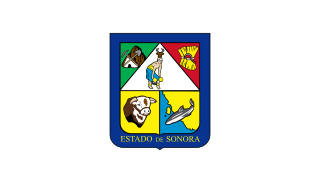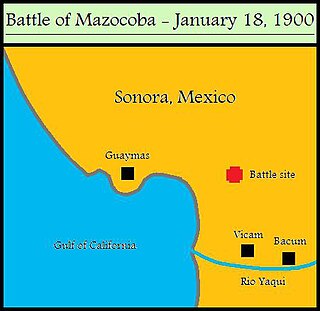
Sonora, officially Estado Libre y Soberano de Sonora, is one of 31 states that, with Mexico City, comprise the 32 federal entities of United Mexican States. It is divided into 72 municipalities; the capital city is Hermosillo. Sonora is bordered by the states of Chihuahua to the east, Baja California to the northwest and Sinaloa to the south. To the north, it shares the U.S.–Mexico border with the states of Arizona and New Mexico, and on the west has a significant share of the coastline of the Gulf of California.

Agua Prieta is a town in Agua Prieta Municipality in the northeastern corner of the Mexican state of Sonora. It stands on the Mexico–U.S. border, adjacent to the town of Douglas, Arizona. The municipality covers an area of 3,631.65 km². In the 2010 census the town had a population of 79,138 people, making it the seventh-largest community in the state, and a literacy rate of 96.3%. 89% of the homes in the city have electricity, 94% have running water, and 86% are connected to the sewer system. The city's most important economic activities, in descending order, are industry, commerce and farming. The city is the location of the CFE Agua Prieta power plant.

Guaymas is a city in Guaymas Municipality, in the southwest part of the state of Sonora, in northwestern Mexico. The city is 117 km south of the state capital of Hermosillo, and 242 miles from the U.S. border. The municipality is located on the Gulf of California and the western edge of the Sonoran Desert and has a hot, dry climate and 117 km of beaches. The municipality’s formal name is Guaymas de Zaragoza and the city’s formal name is the Heróica Ciudad de Guaymas.

The Archdiocese of Hermosillo is a Roman Catholic Archdiocese located in Hermosillo, Sonora, Mexico. Its area is 90,959 sq. miles, and its population (2004) 1,067,051. The bishop resides at Hermosillo.

The Mayo or Yoreme are an indigenous group in Mexico, living in the states of southern Sonora, northern Sinaloa and small settlements in Durango.
The Gasoducto del Sur was a pipeline to supply natural gas to Puerto Rico for conversion to electricity proposed by the administration of Governor Aníbal Acevedo Vilá. The pipeline would have run from Peñuelas, in Puerto Rico's south central coast to electricity-generating plants in Salinas, running in an easterly fashion along Puerto Rico's southern coast. The project aimed to supply a portion of Puerto Rico's electrical energy needs while lowering the cost of electricity in the island.

Bácum is a small city and the county seat of Bácum Municipality, located in the south of the Mexican state of Sonora at 27°32′N110°05′W.

Bavispe is a small town and a municipality in the northeast part of the Mexican state of Sonora.

Fronteras is the seat of Fronteras Municipality in the northeastern part of the Mexican state of Sonora. Frontera translates as Border. The elevation is 1,120 meters and neighboring municipalities are Agua Prieta, Nacozari and Bacoachi. The area is 2839.62 km², which represents 1.53% of the state total.

Bácum Municipality is a municipality of southwestern Sonora, in northwestern Mexico. The population was 21,322 in 2005.
Naco Municipality is a municipality in Sonora in north-western Mexico.
The Vía Verde project, also known as Gasoducto del Norte, was a pipeline project proposed by the administration of Governor Luis Fortuño intended to supply natural gas to northern Puerto Rico from Puerto Rico's southern region. The pipeline would have run from Peñuelas, on Puerto Rico's southern coast, to electricity-generating plants in Arecibo, Cataño and San Juan, crossing the island's Cordillera Central. The project aimed to supply 71% of Puerto Rico's electrical energy needs, while lowering the cost of electricity in the island. A project of Governor Luis Fortuño, it was called the "crown jewel" project of his administration. The project was also supported by former governor of Puerto Rico Rafael Hernández Colón. The pipeline was called "the centerpiece of [Governor Fortuño]'s efforts to kick-start Puerto Rico's dormant economy."

This article details the history of Sonora. The Free and Sovereign State of Sonora is one of 31 states that, with the Federal District, comprise the 32 Federal Entities of Mexico. It is divided into 72 municipalities; the capital city is Hermosillo. Sonora is located in Northwest Mexico, bordered by the states of Chihuahua to the east, Baja California to the northwest and Sinaloa to the south. To the north, it shares the U.S.–Mexico border with the states of Arizona and New Mexico, and on the west has a significant share of the coastline of the Gulf of California.

The Yaqui Wars, were a series of armed conflicts between New Spain, and the later Mexican Republic, against the Yaqui Indians. The period began in 1533 and lasted until 1929. The Yaqui Wars, along with the Caste War against the Maya, were the last conflicts of the centuries long Mexican Indian Wars. Over the course of nearly 400 years, the Spanish and the Mexicans repeatedly launched military campaigns into Yaqui territory which resulted in several serious battles and some infamous massacres.

The Battle of Mazocoba, or the Mazocoba massacre, was a major engagement of the Yaqui Wars that was fought in Sonora, Mexico. On January 18, 1900, a Mexican Army expedition encountered hundreds of Yaqui renegades about twenty miles east of Guaymas. During the battle that followed, several hundred people were killed or wounded and over 1,000 Yaquis were taken prisoner.

Inés Coronel Barreras is a Mexican convicted drug lord and former high-ranking leader of the Sinaloa Cartel, a criminal group based in Sinaloa. He is the father-in-law of Joaquín "El Chapo" Guzmán, the former leader of the cartel and once considered Mexico's most-wanted man. Coronel Barreras was arrested by Mexican security forces in Agua Prieta, Sonora on 30 April 2013. He was sentenced to 10 years in prison on April 28, 2017 for drug trafficking and illegal possession of firearms.
Mario Luna Romero is a tribal secretary of the Yaqui (Yoeme) tribe of Vicam, Sonora. He was a notable spokesperson for the Yaqui people's resistance to the Independence Aqueduct planned in their territory in Sonora. Through 2012 and 2013 the Yaqui of Sonora have blocked major roads. Romero was arrested in September 2014 on charges of kidnapping and autotheft.

The Texas Band of Yaqui Indians are descendants from a band of Mountain Yaqui Indian fighters from Sonora, Mexico. They are now headquartered in Lubbock, Texas. In 2015, the Texas state senate passed a congratulatory resolution, authored by Charles Perry, recognizing the group as Native Americans.

























